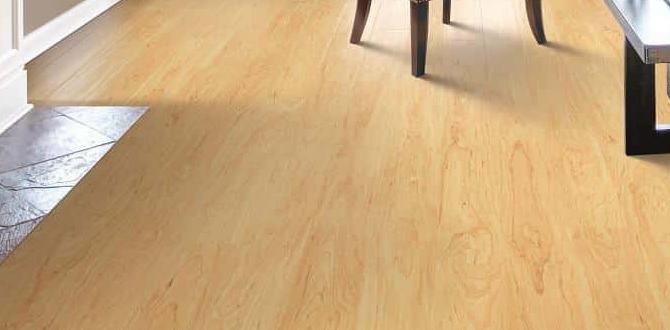Quick Summary: Master nail gun safety for beginners with these essential tips: always wear safety glasses, never point the gun at yourself or others, keep fingers away from the trigger and muzzle, use the correct nail size, and ensure proper workpiece contact before firing. These simple rules prevent accidents and ensure successful DIY projects.
Hey there, DIY warriors and aspiring woodworkers! Jack Shaffer here, your friendly neighborhood Nailerguy. So, you’ve got a project in mind, maybe a birdhouse, a picture frame, or even a small deck, and you’re thinking a nail gun will make things a breeze. That’s a fantastic thought! Nail guns can totally speed up your work and give your projects a professional finish. But, like any powerful tool, they demand respect and a healthy dose of caution, especially when you’re just starting out.
The good news? Using a nail gun safely isn’t rocket science. It’s all about understanding a few key principles and building good habits right from the get-go. We’re going to walk through everything you need to know, step-by-step, so you can feel confident and totally secure wielding your new tool. No more feeling intimidated – we’re going to turn you into a safe and savvy nail gun operator!
Ready to dive in? We’ll cover the absolute must-dos for keeping yourself and everyone around you safe, from picking the right gear to firing that first nail. Let’s get building, safely!
Table of Contents
Frequently Asked Questions About Nail Gun Safety
1. What is the most important safety rule when using a nail gun?
The single most critical safety rule is to always wear ANSI-approved safety glasses or goggles. Nail guns can violently expel nails and debris, and even a small fragment can cause permanent eye damage. Never take them off while the tool is connected to its power source (air, battery, or cord).
2. Can I just rest the nail gun on my project while loading nails?
No, never. Always keep your fingers away from the trigger and the nose of the nail gun, especially when loading or handling the tool. Don’t ‘dry fire’ (fire without a nail) or point the gun at anything you don’t intend to nail. Treat it like a firearm in terms of muzzle discipline.
3. What’s the difference between “contact actuation” and “sequential actuation” modes, and which is safer?
Sequential actuation (also called “proximity trigger” or “fire-then-move”) is generally considered safer for beginners. You must first press the safety contact tip against the workpiece and then pull the trigger to fire a nail. This significantly reduces the chance of accidental firing. Contact actuation fires a nail every time the trigger is pulled AND the contact tip is depressed. This is faster but much more prone to accidental discharge if mishandled.
4. Do I need to wear hearing protection with a nail gun?
Yes, especially with pneumatic (air-powered) nail guns. The sudden burst of air can be loud enough to cause hearing damage over time. Earplugs or earmuffs are a good idea for prolonged use. Electric and battery-powered models might be quieter, but it’s still wise to check the manufacturer’s recommendations.
5. What if my nail gun jams? How do I fix it safely?
First, disconnect the power source immediately (unplug the air hose, remove the battery, or unplug the cord). Never try to clear a jam while the gun is still connected. Consult your owner’s manual for specific jam-clearing instructions. Often, it involves releasing pressure and using a tool to gently remove the jammed nail. Always wear safety glasses when clearing jams.
6. Can I use any nail in any nail gun?
Absolutely not. Nail guns are designed for specific types and sizes of nails. Using the wrong nails can lead to jams, damaged tools, or dangerous misfires. Always check the nail gun’s specifications and use only the recommended nails (e.g., finish nails, brad nails, framing nails) of the correct gauge and length.
Your Essential Nail Gun Safety Gear
Before you even think about loading a nail, let’s talk about getting kitted out. Having the right personal protective equipment (PPE) isn’t just a suggestion; it’s the absolute foundation of safe nail gun operation. Think of this gear as your suit of armor against potential hazards. They’re inexpensive and incredibly effective at keeping you safe.
1. Eye Protection: Non-Negotiable!
This is the big one, folks. Your eyesight is precious, and a flying nail or splinter is no joke. You need more than just sunglasses.
- Safety Glasses: Look for ANSI Z87.1 rated safety glasses. They should have side shields for comprehensive protection.
- Goggles: For tougher jobs or if you’re working in dusty conditions, full-coverage goggles offer an extra layer of security.
- Clear Lenses: Always use clear lenses so your vision isn’t impaired, especially in lower light conditions.
Always ensure your eye protection fits snugly and comfortably. If you wear prescription glasses, you can get safety glasses that fit over them, or invest in prescription safety glasses.
2. Hearing Protection: Protect Your Eardrums
Especially for pneumatic nail guns, the sound of firing can be quite loud. Repeated exposure to loud noises can lead to permanent hearing loss. Over time, this can be a serious issue. Don’t ignore this aspect of safety!
- Earplugs: Disposable or reusable earplugs are a convenient option.
- Earmuffs: Earmuffs provide excellent protection and can be easier to put on and take off quickly if you need to chat with someone.
Make it a habit to grab your hearing protection whenever you grab your nail gun. It takes just a few seconds and can save you a lifetime of regret.
3. Work Gloves: For Grip and Protection
While not directly protecting you from nail-related injuries (that’s what eye protection is for!), good work gloves offer several benefits.
- Improved Grip: A better grip on the nail gun reduces the chance of it slipping, which can lead to accidents.
- Reduced Fatigue: They can help reduce vibration and provide some cushioning, making it more comfortable to hold the tool for longer.
- Minor Protection: They offer a bit of protection against splinters, rough surfaces, and minor scrapes.
Opt for gloves that offer good dexterity so you don’t lose your feel for the tool. Leather or synthetic gloves are usually great choices.
4. Sturdy Footwear: Keep Your Feet Safe
Always wear closed-toe shoes, preferably sturdy work boots. This protects your feet from dropped tools, fasteners, or debris. Tripping hazards are also less of an issue when you have good traction.
Understanding Your Nail Gun: Know Its Features
Nail guns come in various flavors – pneumatic, electric, and even cordless battery-powered. Each type has its nuances, but the core safety principles remain the same. Before you fire it up, take a moment to get acquainted with your specific tool. Reading the manual is a key step here, no matter how tempting it is to just jump in!
Common Nail Gun Types
Understanding what you’re working with helps a lot:
- Pneumatic Nailers: The most common type, powered by an air compressor. They’re powerful and versatile. Safety Note: Ensure the air hose is in good condition and securely connected.
- Electric Nailers: Plugs into a standard outlet. Great for indoor projects and lighter tasks. Safety Note: Keep the power cord away from the work area and the nail gun’s path.
- Battery-Powered (Cordless) Nailers: Offer the most freedom of movement. Powered by rechargeable batteries. Safety Note: Properly store batteries when not in use and replace any damaged battery packs.
Trigger Mechanisms: Sequential vs. Contact
This is a really important feature regarding safety. Nail guns typically have one of two trigger modes:
| Trigger Type | How it Works | Best For | Safety Considerations |
|---|---|---|---|
| Sequential Actuation (Also known as “Fire-then-Move” or “Proximity Trigger”) |
You must first press the safety contact tip against the workpiece, then you can pull the trigger to fire one nail. To fire another nail, you must lift the tip and re-engage it. | Beginners! Framing, finish carpentry, tasks requiring precise nail placement. | Significantly reduces accidental firing. The safest option for new users. |
| Contact Actuation (Also known as “Bump Fire” or “Trigger Fire”) |
The gun can fire nails as long as the trigger is held down AND the safety contact tip is depressed. You can “bump” the nose against the wood and pull the trigger repeatedly to fire multiple nails quickly without re-engaging the trigger each time. | Speed-critical tasks like sheathing or roofing (with proper training). | Increases risk of accidental firing if the trigger is accidentally held down, or if the tip contacts something unintended. Requires more control and practice. |
For beginners, I strongly recommend using a nail gun with sequential actuation if possible. It is much more forgiving and prevents those “oops” moments where a nail goes where you didn’t intend it to. If your tool only has contact actuation, take extra care to keep your finger OFF the trigger until you are ready to fire.
The Safety Contact Tip (Nose)
This is the part of the nail gun that you press against the material before firing. It has a crucial safety function.
- Purpose: It prevents the gun from firing unless it’s pressed firmly against a surface. This is built-in safety to stop accidental firing when you’re just holding or carrying the tool.
- Maintenance: Keep this tip clean and free of debris. If it’s damaged or not functioning correctly, the gun might misfire or fail to fire.
Never modify or disable the safety contact tip. It’s there for a good reason!
Your Top Safety Rules for Using a Nail Gun
Alright, we’ve got the gear, we understand the tool a bit better. Now, let’s get into the golden rules. These are the things you need to have imprinted in your brain before you even pick up that nail gun for your project. Think of this as your pre-flight checklist.
-
1. ALWAYS Wear Eye Protection
I know, I know, I’ve said it. But it’s worth saying again. No exceptions. Not for a second. Not for one nail. Always wear your ANSI-approved safety glasses or goggles.
-
2. Treat it Like a Weapon
This is a saying for a reason. Never point the nail gun at yourself, another person, or any part of your body. Always assume it’s loaded. Keep your fingers away from the trigger AND the nose of the gun when you’re not actively firing a nail.
-
3. Ensure Proper Workpiece Contact
For both sequential and contact actuation modes, the safety contact tip MUST be pressed firmly against the workpiece before you pull the trigger for sequential, or before you set it down to fire for contact. This prevents the nail from firing into open air or at an angle.
-
4. Keep Your Finger OFF the Trigger
This is especially crucial if you’re using a contact actuation nailer. Your finger should only be on the trigger when you are intentionally firing a nail at your intended target. When moving, carrying, or adjusting the tool, your finger should be completely off the trigger.
-
5. Disconnect Power When Not in Use
This is universally important. When you are:
- Loading nails
- Clearing a jam
- Adjusting settings
- Attaching/detaching accessories
- Walking away from the tool
- Performing maintenance
…always disconnect the power source! For air nailers, that means disconnecting the air hose. For electric or battery nailers, remove the battery or unplug it from the wall. This is a critical step to prevent accidental firing.
-
6. Use the Right Nails
Nail guns are designed for specific types and sizes of fasteners. Using the wrong nail can cause jams, damage the tool, or lead to dangerous situations where the nail doesn’t drive properly or ricochets. Always consult your nail gun’s manual or markings for the correct gauge, length, and type of nails.
For example, framing nailers use larger, more powerful nails than finish nailers. A coil nailer might accept different nails than a strip nailer.
-
7. Don’t Overreach or Work on Unstable Surfaces
Maintaining good balance and footing is essential. If you have to stretch too far or stand precariously to place a nail, stop and reposition yourself or your workpiece. A fall can easily lead to dropping the nail gun or misfiring it.
Working on ladders? Be extra cautious. Never use a nail gun from a wobbly ladder or while on an unstable platform. Ensure you have a firm stance.
-
8. Proper Nail Placement
Aim for a square, direct connection between the nail gun’s nose and the material. Avoid firing nails into knots or very hard sections of wood that might cause the nail to split or ricochet. If you’re nailing thin material, consider a nailer with a depth adjustment feature to prevent over-penetration, which can be a hazard.
For more information on choosing the right fasteners for your project, check out resources from organizations like the Occupational Safety and Health Administration (OSHA), which provides detailed guidelines on power tool safety, including nail guns.
-
9. Clear Jams Safely
Jams happen, but clearing them requires care. Always, always disconnect the power source first (air, battery, or cord). Never try to force a jam while the gun is powered. Consult your manual for the correct procedure. Often, it involves releasing any spring tension, removing nails from the magazine, and gently extracting the jammed fastener.
-
10. Keep Others at a Safe Distance
Make sure bystanders, especially children and pets, are well away from your work area. A stray nail can travel surprisingly far. Ensure only trained and authorized users operate the nail gun.
Nail Gun Maintenance: A Safety Essential
A well-maintained nail gun is a safer nail gun. Regular check-ups and proper care prevent malfunctions that could otherwise lead to accidents. Think of it as part of your safety routine.
Keep it Clean
Dust, wood chips, and debris can interfere with the proper functioning of your nail gun. Regularly clean the exterior and the moving parts, especially the safety contact tip and the nose assembly.
Proper Lubrication (for Pneumatic Nailers)
Pneumatic nailers require a small amount of air tool oil to keep the




